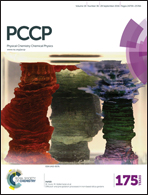Encapsulation capacity and natural payload delivery of an anticancer drug from boron nitride nanotube
Abstract
The behavior of confined anticancer carboplatin (CPT) molecules in a single (10, 10) boron nitride nanotube (BNNT) was studied by means of molecular dynamics simulations. Our study revealed a very large storage capacity of BNNT. Analysis of the energy profiles depending on the number of confined molecules, and on their spatial organization allowed us to quantify the ability of BNNT to vectorize CPT. Indeed, BNNT despite its small radius presented a large inner volume that favored stable encapsulation of multiple active anticancer molecules. Moreover, in our molecular dynamics simulations, the empty BNNT and the BNNT filled with CPT diffused spontaneously to the cell membrane and were able to passively enter inside lipid bilayers by a lipid-assisted mechanism. This property has been used to deliver naturally anticancer drugs to cellular targets. Using this enhanced drug delivery system, we have provided a definitive solution to the problem of drug release and have thus opened up a new way of targeting cancer cells. Indeed, regardless of the mode of action of the platinum complex towards the cell, the delivery of the drug on site should limit the side effects of the drug.


 Please wait while we load your content...
Please wait while we load your content...